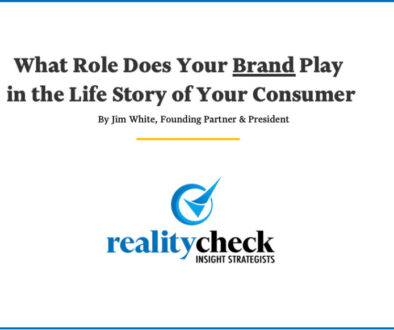Narrative Power: Brands, Identity, and the Stories We Tell Ourselves
When I was in college at the University of Kentucky, I drank a lot of cheap beer. Like many undergrads, I didn’t think much about what I was drinking—only that it was cold and affordable. But one summer, that changed.
I was twenty years old, working as a news intern at the Knoxville News-Sentinel—my first grown-up job in a real newsroom with real journalists. I was a Kentuckian in Tennessee, trying to prove myself. Not just to the people around me, but to myself.
That summer, when we went out for happy hour, I stopped ordering beer. I started ordering Maker’s Mark. I hadn’t had much bourbon before, but I knew Maker’s was a premium Kentucky brand. By choosing Maker’s Mark—over the far more popular and well-known Jack Daniel’s, a Tennessee whiskey—I was signaling two things at once: I could handle an adult drink, and I was proud of where I came from.
In that small act, I was telling my colleagues that I belonged. But more importantly, I was telling myself that I was becoming the kind of person I aspired to be.
A decade later, I found myself working as director of strategy at an ad agency. My largest client? Maker’s Mark. I had the opportunity to work for Bill Samuels Jr., the son of the founder and a visionary marketer. Long before bourbon was cool, Bill saw something few others did: that bourbon didn’t have to be bottom-shelf.
He turned a handcrafted Kentucky whiskey into the first premium bourbon brand—and in doing so, helped lay the foundation for an entire cultural and economic revival. Today, bourbon isn’t just consumed—it’s collected, revered, even fetishized. Brands like Pappy Van Winkle have achieved near-mythic status. Bourbon has become, in many ways, America’s answer to single malt Scotch: a drink steeped in heritage, meaning, and identity.
Through smart storytelling and cultural positioning, Maker’s Mark transformed from a regional product into a global symbol. A symbol of pride, place, and personal taste. A symbol that meant something.
And here’s the thing: even after all these years—and even with shelves now packed with small-batch labels and collector’s editions—I remain loyal to Maker’s Mark. Not out of habit. Out of meaning. Because of the story I first told myself at twenty.
That’s what so many people misunderstand about brands. We think they’re about signals to others. But the more powerful story—the one that really shapes behavior—is the story we tell ourselves.
This is the core idea behind what we call Narrative Power: a brand’s ability to become part of the identity story a person tells about who they are, who they were, and who they are becoming. It’s the psychological and cultural force that allows a brand to matter deeply—not just in the marketplace, but in the mind, and even in the self.
Some brands help people close a gap. They become the thing you buy or use when you feel a distance between who you are and who you want to be. They motivate you. They comfort you. Sometimes they’re aspirational; sometimes they’re a lifeline. They help you believe in your own potential.
Other brands help you affirm who you already are. They reflect your values. They bring back powerful memories. They say something about where you come from or who your people are. These brands are less about becoming and more about being—a kind of shorthand for self-recognition or social connection.
And some brands help you hold your story together. They’re with you across different phases of life. They carry meaning from the past, into the present, and into the future. They are narrative touchstones—objects, logos, rituals—that reinforce the plotline of your life.
The strongest brands don’t just operate on one of these levels. They move across them. They show up in a moment of aspiration and stick with you through reflection, growth, and change. They live in memory and routine. They gain texture and richness over time.
These are not just the brands we buy. They’re the brands we buy into.
What makes these brands so powerful? It’s not just the marketing. It’s not just the storytelling. It’s something deeper: story alignment. These brands succeed not because they force their story onto people—but because they find resonance with the stories people are already telling themselves.
Think of the brands that have stayed with you over the years—not just the ones that performed well, but the ones that felt like they meant something. Maybe it’s a brand of car that reminds you of your parents. Maybe it’s a running shoe that got you through your first marathon. Maybe it’s a skincare product that helped you feel confident during a tough season. Whatever it is, the emotional power isn’t just in the product. It’s in the meaning you’ve attached to it.
And that meaning is personal. It’s psychological. It’s often invisible to outsiders—but central to the person experiencing it.
That’s why brands can’t afford to think of themselves as just products or messages. They have to see themselves as characters in a much bigger story—a story being told, retold, and revised by consumers every day.
This is especially true in today’s identity-driven marketplace. We live in a world of increasing self-awareness, self-expression, and self-curation. People are crafting identities across multiple platforms, communities, and life stages. And in the midst of all that, they’re looking for things that make sense of it all. Things that anchor them. Things that reflect their values and aspirations. Things that help them become—or remain—the person they want to be.
In a fragmented, fast-moving world, Narrative Power may be the most enduring form of brand strength. Because it’s not just about being seen. It’s about being believed—and belonging.
And the brands that understand this? They don’t just win market share. They win mindshare. Heartshare. Lifeshare.
So as you think about your brand—whether you’re a strategist, marketer, founder, or designer—ask yourself the real question:
What story does your brand help someone tell about themselves?
At RealityCheck, we continue to develop what we call Narrametric™ Analysis – the science of brands and narrative identity. It’s a research-based approach to understanding how identity and narrative tension operate across different consumer segments and product categories. By mapping the stories people are trying to tell about themselves—and the tensions they feel between who they are and who they want to be—we can evaluate how well a brand’s positioning, creative, and communications align with those stories. We’ve created tools to measure and track a brand’s Narrative Power over time, giving marketers a clearer view into what makes a brand matter—and how to make it matter more.
Because in the end, the most powerful brands don’t just do a functional job for people. They help people tell stories about who they are – and who they want to be.

![[TEMPLATE] Blog Post Title Slides [TEMPLATE] Blog Post Title Slides](https://realitycheckinc.com/wp-content/uploads/2025/08/TEMPLATE-Blog-Post-Title-Slides.png)
![[TEMPLATE] Blog Post Title Slides [TEMPLATE] Blog Post Title Slides](https://realitycheckinc.com/wp-content/uploads/2025/06/TEMPLATE-Blog-Post-Title-Slides-1024x576-394x330.png)





















